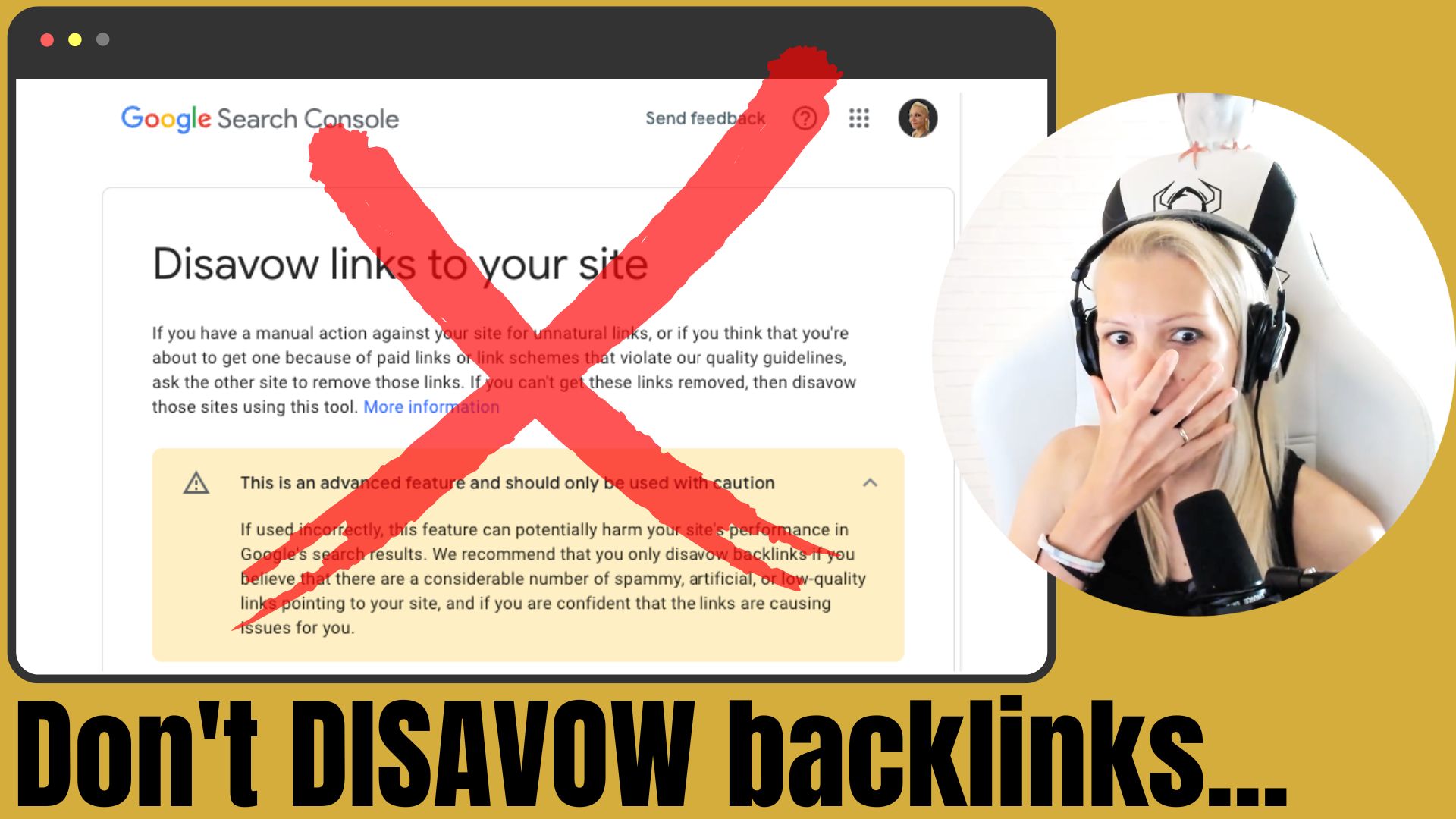
Updated: July 30, 2023.
Learn what disavowing links is, when to disavow links, and why you most likely don’t need to do this.
I wish there were more guides like this one. Read it until the end if you are thinking about disavowing backlinks (or if your SEO agency is suggesting this).
It’s easy to find hundreds of guides on how to disavow backlinks, how to file a disavow in Google Search Console, how to disavow TOXIC links, etc.
However, there are way too few guides telling you the truth about what this process really means and why in most cases it can do you more harm than good.
This is one of the few guides!
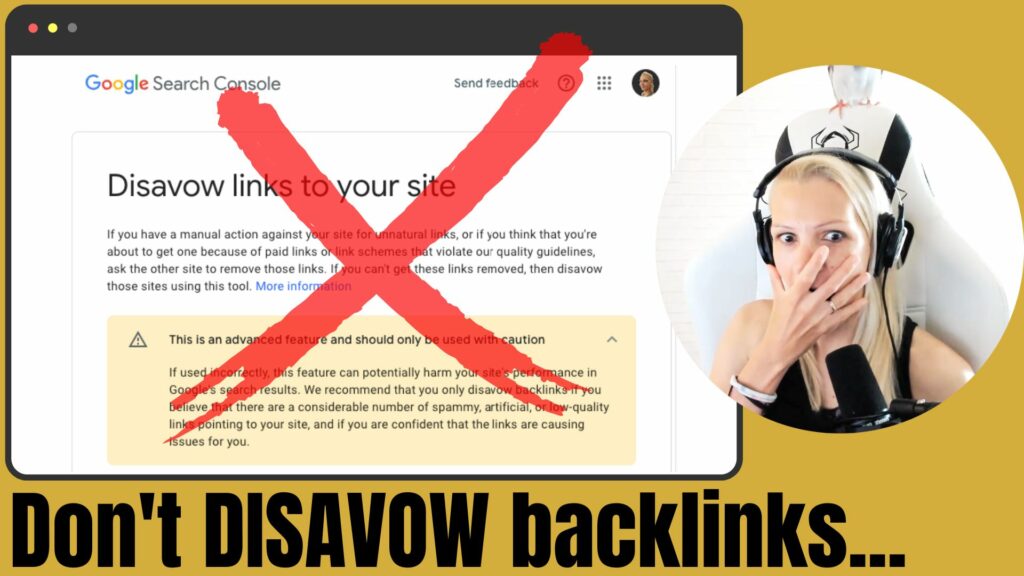
What is the Google Disavow Tool?
The Google Disavow Tool is an advanced feature in Google Search Console that allows website owners to “disavow” certain backlinks pointing to their website.
The tool is part of Google Search Console but it’s nowhere to be found in Google Search Console. You need to specifically Google it (more about that later) to find it because this is an advanced tool likely to be misused.
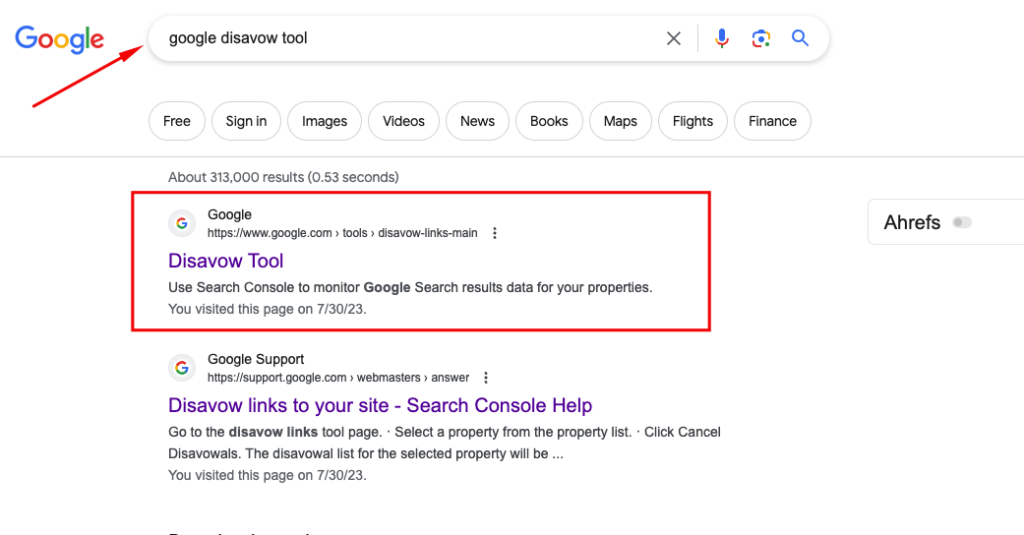
What does the Disavow Tool do?
By disavowing a link, you are telling Google not to use that link when assessing your site’s credibility and ranking it in search results. The disavow tool serves as a way for website owners to indicate that certain links to their site are spammy or otherwise “unnatural” in the eyes of Google.
- The disavow process involves exporting a list of all external links to your site from Search Console (or/and other SEO tool that shows backlinks like Semrush or Ahrefs), then creating a text file containing the specific links you wish to disavow.
- This text file is uploaded to the Disavow Links tool, signaling to Google’s algorithms that those links should be discounted.
- By disavowing unwanted links, the intention is to prevent them from negatively influencing rankings.
NOTE: It’s important to understand this is an advanced feature that should be used with caution. Google offers it as a solution to cleanup efforts after receiving manual actions or link penalties. But disavowing links without reason can potentially harm your site.
When should you use the Disavow Tool?
The Google Disavow Tool should only be used if you have received a manual penalty related to unnatural links pointing to your site.
Specifically, if Google has sent you a message in Search Console about detecting “unnatural links” or patterns of manipulation, then the Disavow Tool can help clean up the penalty.
However, the Disavow Tool should not be used as a general best practice or preventative measure. It is considered an advanced procedure that carries risks if used improperly. Just because you have some low-quality links does not mean you should blindly disavow them.
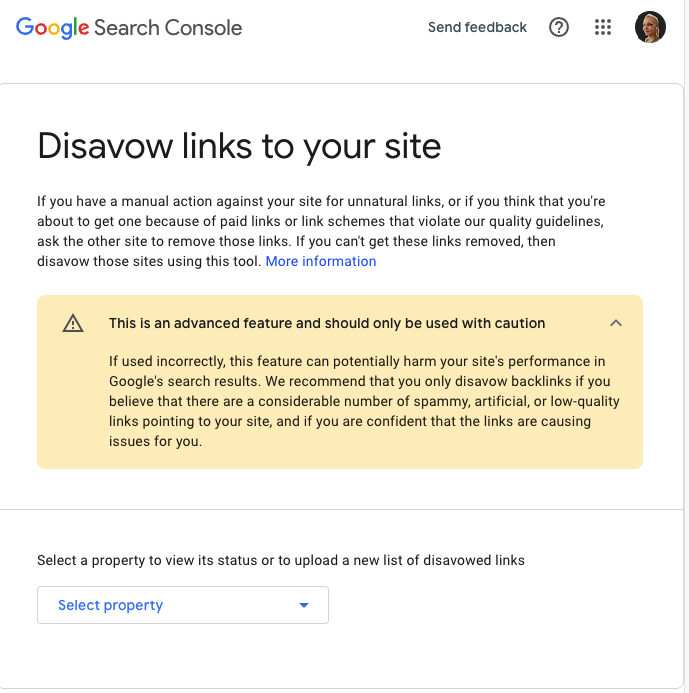
If you aren’t going to read until the end of this article, make sure to check those key points on when the Disavow Tool should and should not be utilized.
When to disavow backlinks:
- If you have been manually penalized by Google for unnatural links. This penalty message will come through Search Console (and you will likely be notified via e-mail too).
- If you self-identify significant spammy links resulting from your own poor SEO practices in the past.
When not to disavow backlinks
- As a standard protocol without any manual action. Disavowing links without reason can harm your site.
- If you simply notice some low-quality or “toxic” links in an audit. This is common and not a reason to disavow.
- As a speculative preventative measure. Google algorithms can already detect and ignore spammy links.
The Google Disavow Tool is considered a last resort solution for serious unnatural link penalties. Casual use without cause can do more harm than good. Having some low-quality links is expected and not a reason to go filing disavows.
Google Manual Actions and disavowing links
In 99,9% of cases, only having a manual action for unnatural links should be the reason why you file a disavow in Google Search Console.
Google has two primary types of manual actions related to unnatural links described below.
Unnatural links to your site (a reason to disavow)
Unnatural links to your site means Google detected manipulative links from other sites pointing to yours.
For example, buying links or participating in link exchange schemes violates Google’s guidelines. If found, Google may apply a manual action penalizing your site’s rankings.
Here is a very old but still very valid video on this type of manual action.
The Disavow Tool specifically comes into play if you have received a “Unnatural Links to Your Site” manual action. This penalty means you need to clean up manipulative backlinks from other sites pointing to yours.
The Disavow Tool allows you to isolate links you cannot otherwise get removed, so Google will disregard them. Keep in mind that Google wants you to make an actual effort at cleaning spammy backlinks as opposed to blindly putting them all into the disavow file.
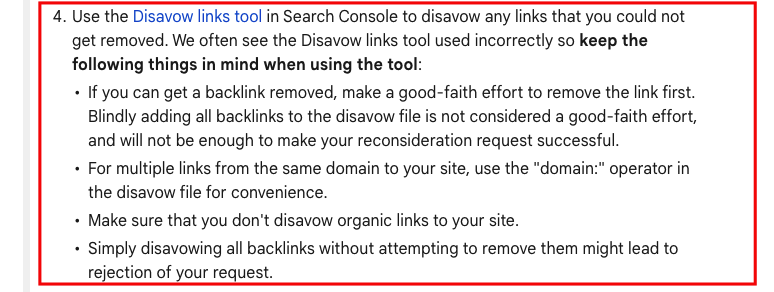
Unnatural links from your site (not a reason to disavow)
In this case, Google detected manipulative outbound links on your own site pointing to others. This could include paid links, excessive reciprocal links, or other schemes aiming to artificially boost PageRank. The penalty applies to your site for participating in manipulation.
Here is another very old video explaining this type of manual action. You will recognize Matt Cutts from this video only if you have been in SEO for 9-10 years at least 😉
NOTE: If you receive the other type of action for “Unnatural Links from Your Site”, the disavow process is not applicable, since that involves outbound links on your own site that need to be fixed or removed.
Don’t disavow just because you have spammy links
It is completely normal for websites to have some percentage of spammy, low-quality links pointing to them. This is just a natural part of participating in the interconnected web. Even the most authoritative sites, like Google.com, have such links show up in backlink analysis tools.
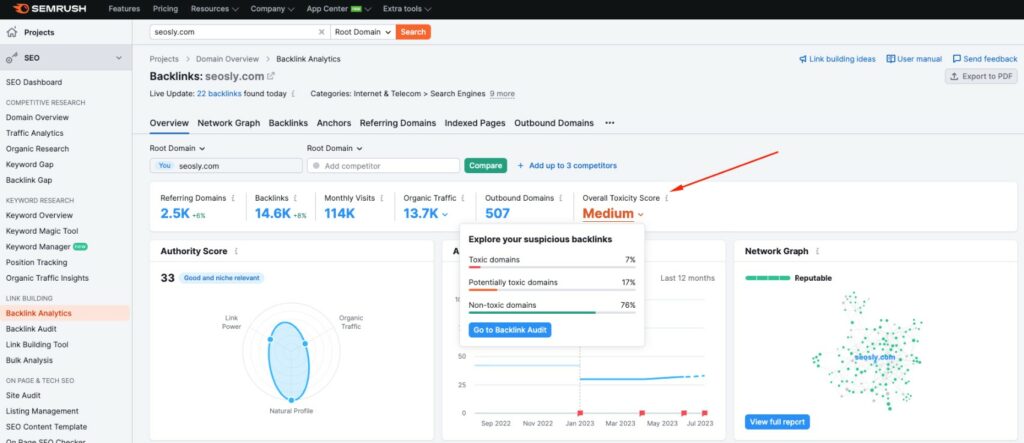
The presence of some bad links does not inherently mean you should jump to disavow them. Every website will attract an amount of junk links from questionable sources due to the public nature of the web.
Seeing some spammy-looking links in your backlink profile is not a reason to instantly disavow them. These links are generally ignored by Google anyway if the site otherwise has a solid reputation.
You should only disavow backlinks if:
- You have an actual Google manual action for unnatural links.
- You personally built large amounts of manipulative links that could warrant a penalty.
Outside of those specific situations, casually disavowing links without cause can do more harm than good. It may signal to Google that you have something to hide.
NOTE: The lesson is – some percentage of low-quality links is expected and not a reason to panic. Having a few spammy links turn up is normal on any domain with age. Focus on building your site’s value, not scrubbing links most users will never notice in the first place.
Watch out for dishonest SEO agencies selling spammy link removal
Some questionable SEO agencies try to profit by selling unnecessary “spammy link removal” or “backlink audit” services. They convince site owners they need to pay fees for the agency to analyze backlinks and create disavow files.
- Often this busywork is done without any manual penalty from Google as a speculative “optimization.” However, blindly disavowing links without reason can actually damage your site’s performance.
- The agency essentially manufactures make-work, knowing most sites naturally accrue some bad links that Google already ignores. This creates the illusion of value for their analysis and disavow file creation.
- But if you don’t have a specific manual action from Google for unnatural links, disavowing can do more harm than good because you may actually disavow good quality links that are helping you. I’ve really seen lots of such cases, unfortunately.
NOTE: If approached by an agency about such backlink investigation services, make sure you have a confirmed manual penalty first. Any reputable firm would not recommend arbitrarily disavowing links without evidence they are hurting you. Most sites never need to touch the Disavow Tool.
The dangers of misusing the Disavow Tool
While the Disavow Tool serves an important purpose, it also carries significant risks if used improperly or arbitrarily. Here are some key dangers to be aware of.
Disavowing links without a penalty can hurt rankings
Casually disavowing links without evidence they are harmful may actually lead to good quality links being ignored, which as a result can hurt your rankings. This can be especially painful if you go on a link disavowing spree and disavow the entire domains instead of specific links.
Again, I’ve seen it too many times when website owners disavowed hundreds or thousands of domains.
Hard to undo a wrong disavow file once submitted
Submitting an improperly constructed disavow file can potentially harm your site’s performance in Google search results. Here are some key dangers to note:
- If you disavow high-quality, reputable links by mistake, removing signals Google wants, this can hurt your rankings.
- Even if you later remove or modify a faulty disavow file, the effects of disavowing good links may linger for some time (or even permanently).
- Google needs to re-crawl the previously disavowed URLs and re-process all signals. This takes weeks (or months) to fully complete. I don’t believe Google immediately recrawls the disavow file and reassess your site.
- There is no guarantee your site’s previous performance will be restored once a bad disavow file is fixed. The effects could persist.
- Arbitrarily disavowing a wide range of links without justification can appear manipulative to Google’s algorithms.
The takeaway is to be extremely cautious when compiling your disavow file. Only include verified low-quality links. Double check for any accidental additions of links you want to keep.
NOTE: Submitting a careless, over-aggressive disavow file can do lasting damage that is difficult to undo. It may permanently impact search performance.
Easy to accidentally disavow good links
Mistakes happen. It’s easy to accidentally include high-quality links in your haste to disavow poor ones. This removes signals Google actually wants, hurting your performance.
While the Disavow Tool serves a purpose, misuse carries significant danger. AGAIN, only use it to clean up confirmed manual actions – not for speculative optimization attempts. Disavowing without cause can backfire.
And there is also a video where he talks about the Disavow File and how NOT to use it.
Tips for using the Disavow Tool
If you have a manual penalty requiring use of the Disavow Tool, here are some best practices:
Be 100% certain of spammy links before disavowing
Carefully verify any link you want to disavow is truly suspicious and meant to manipulate ratings. Avoid recklessly adding links without evidence they are harmful. Document why each link merits disavowing.
Prioritize removing bad links rather than just disavowing
Make every effort to actually get unnatural links taken down, rather than just disavowing them. Removing them from the web entirely is better. Disavowing should only be a last resort for what can’t be removed.
Disavowing entire domains can be risky
When possible, target individual bad pages rather than blanket domain disavows. For example, disavow example.com/badpage.html rather than the entire example.com domain. This reduces the **** of accidentally discarding good signals.
TIP: Be selective, meticulous, and surgical when compiling your disavow file. Double check your work. Google rewards thoughtful, precise disavowing – not blind shotgun blasts at links you simply don’t like.
Glenn Gabe has a very interesting case study on what happened when the site owner finally removed a disavow file with 15K+ domains.

How to disavow backlinks (instructions)
Okay, I think I’ve issued enough warnings, so if you have a confirmed manual penalty for unnatural links, here are step-by-step instructions on properly using the Disavow Tool.
Note that Google also has a very decent guide on how to disavow links using the disavow tool.
1: Create a Disavow List
First, you need to create a list of pages or domains you wish to disavow. This list should be assembled in a text file that you will upload to Google. The list should follow a specific format – one URL or domain per line, encoded in UTF-8 or 7-bit ASCII. You can include comments by starting a line with a ‘#’. Google will ignore these lines.
For example:
# Two pages to disavow
http://spam.example.com/stuff/comments.html
http://spam.example.com/stuff/paid-links.html
# One domain to disavow
domain:shadyseo.com
2: Upload Your Disavow List
Next, go to the disavow links tool page on Google Search Console and select the property for which you want to disavow links. Note that you can only submit disavow files for URL-prefix properties.
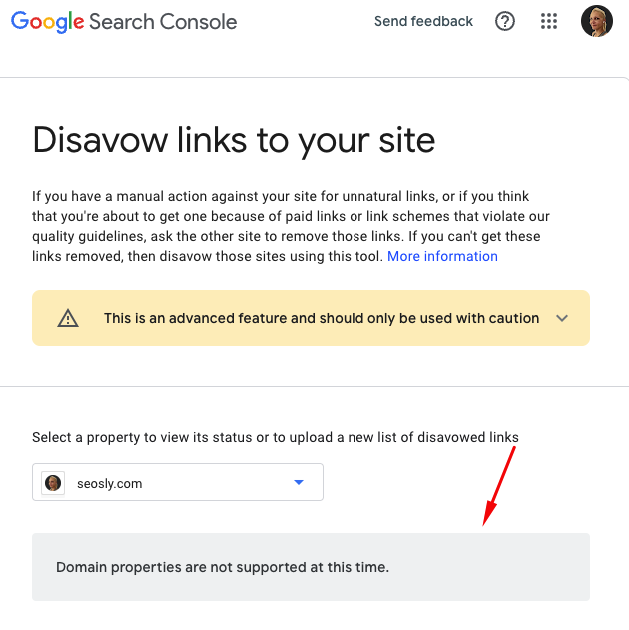
Click the upload button and choose the disavow file from your local computer. Remember that uploading a new disavow list will replace any existing list for that property. It may take several weeks for Google to process your disavow list.
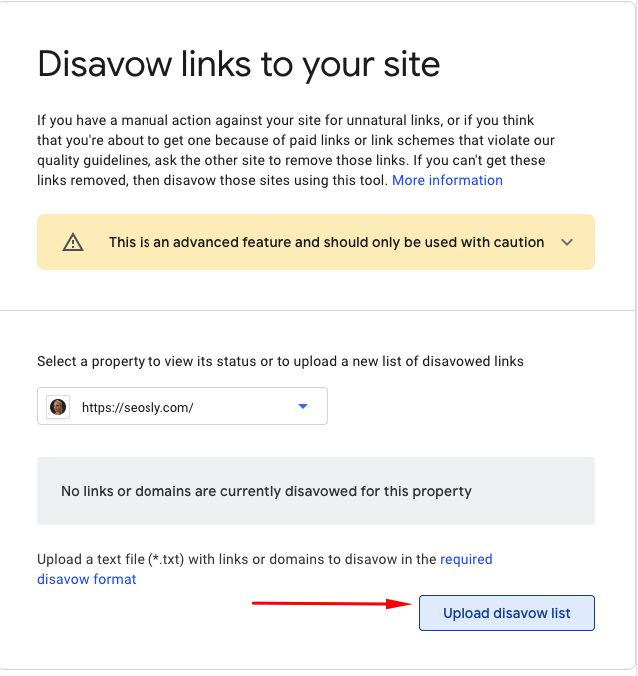
If the file has errors, Google will provide a list of those errors, and you can make the necessary changes and try uploading again.
Removing All Disavowals
If for some reason (or a good reason) you want to remove all disavowals for a property, go to the disavow links tool page, select the property, and click ‘Cancel Disavowals’. It may take several weeks for Google to remove these disavowals from their index.
Bear in mind that this process is reversible but should be undertaken with utmost caution as the consequences of misuse could negatively impact your site’s performance in Google Search.
FAQs on disavowing links and using the Google Disavow Tool
Here are some of the most often asked questions when it comes to disavowing backlinks and using the Google Disavow Tool in general.
What is the Google Disavow Tool and where do I find it?
The Disavow Tool is a way to tell Google not to use certain spammy links pointing to your site. It is not directly available in Google Search Console – you have to search for “Google Disavow Tool” to access it as a precaution.
When should I use the Google Disavow Tool?
Only if you have a manual action against your site for unnatural links. Don’t use it speculatively or preventatively.
What are the risks of misusing the Disavow Tool?
Disavowing good links by accident, disavowing without a penalty, and being overly aggressive can harm your site. Google may ignore arbitrary disavowal requests.
What is a manual action?
A notice from Google that a human reviewer assessed your site and applied a penalty for violating guidelines. This is required to rightly use the Disavow Tool.
How do I know if I have a manual action?
Check the Manual Actions report in Google Search Console. You will see a notice if your site has a manual penalty.
What are the two types of manual actions for unnatural links?
“Unnatural links to your site” means you were penalized for manipulative inbound links. “Unnatural links from your site” means outbound manipulative links.
When specifically should I disavow backlinks?
If you have the “Unnatural links to your site” manual action. The Disavow Tool is for cleaning up bad inbound links.
If I have an unnatural links manual action, what should I do?
First remove as many violating links as possible. Then disavow remaining unremovable links. Finally, request a review.
How do I find bad links to disavow?
In Search Console, under Links to Your Site, download your site’s backlinks. Review them to identify unnatural links.
What is the format for a disavow file?
Plain text with one link per line. Use “domain:” to disavow entire domains. Add comments with #.
How do I submit a disavow file to Google?
In the Disavow Links tool, select your site and upload your text file. Google will process the disavowed links.
How long does it take for a disavow file to fully process?
Google needs to recrawl then reindex the disavowed links, which can take several weeks to complete.
Can I undo an incorrect disavow file?
You can replace a bad disavow file with a corrected one. But effects take time to propagate through Google’s systems.
Should I disavow typical low-quality links?
No, some percentage of spammy links is expected. Don’t panic and blindly disavow at the first sight of a bad link.
What should I do if an SEO agency offers link disavow services?
Verify you have a specific unnatural link manual action first before approving disavow work. Make sure it is necessary.



